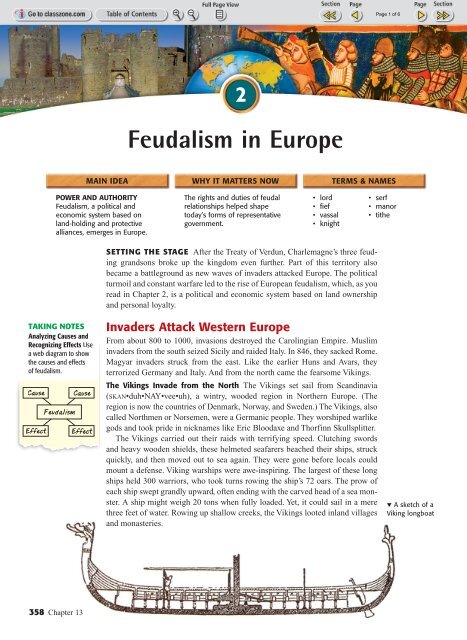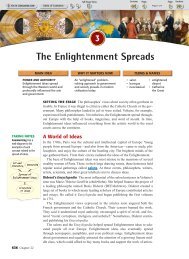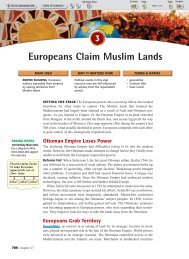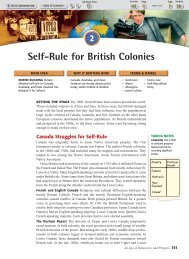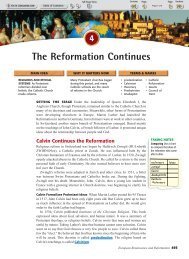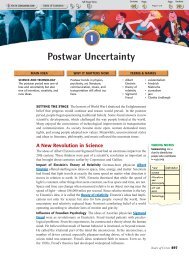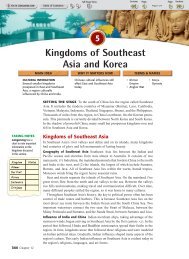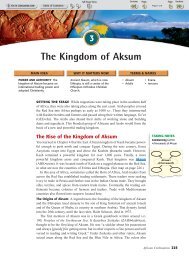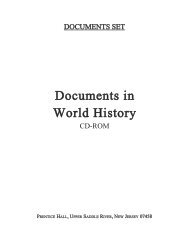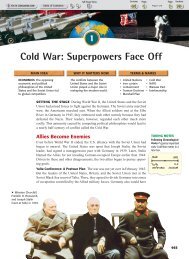Feudalism in Europe - Euro-webonline.com
Feudalism in Europe - Euro-webonline.com
Feudalism in Europe - Euro-webonline.com
- No tags were found...
You also want an ePaper? Increase the reach of your titles
YUMPU automatically turns print PDFs into web optimized ePapers that Google loves.
<strong>Feudalism</strong> <strong>in</strong> <strong><strong>Euro</strong>pe</strong>2MAIN IDEA WHY IT MATTERS NOW TERMS & NAMESPOWER AND AUTHORITY<strong>Feudalism</strong>, a political andeconomic system based onland-hold<strong>in</strong>g and protectivealliances, emerges <strong>in</strong> <strong><strong>Euro</strong>pe</strong>.The rights and duties of feudalrelationships helped shapetoday’s forms of representativegovernment.• lord• fief• vassal• knight• serf• manor• titheTAKING NOTESAnalyz<strong>in</strong>g Causes andRecogniz<strong>in</strong>g Effects Usea web diagram to showthe causes and effectsof feudalism.CauseEffect<strong>Feudalism</strong>CauseEffectSETTING THE STAGE After the Treaty of Verdun, Charlemagne’s three feud<strong>in</strong>ggrandsons broke up the k<strong>in</strong>gdom even further. Part of this territory alsobecame a battleground as new waves of <strong>in</strong>vaders attacked <strong><strong>Euro</strong>pe</strong>. The politicalturmoil and constant warfare led to the rise of <strong><strong>Euro</strong>pe</strong>an feudalism, which, as youread <strong>in</strong> Chapter 2, is a political and economic system based on land ownershipand personal loyalty.Invaders Attack Western <strong><strong>Euro</strong>pe</strong>From about 800 to 1000, <strong>in</strong>vasions destroyed the Carol<strong>in</strong>gian Empire. Muslim<strong>in</strong>vaders from the south seized Sicily and raided Italy. In 846, they sacked Rome.Magyar <strong>in</strong>vaders struck from the east. Like the earlier Huns and Avars, theyterrorized Germany and Italy. And from the north came the fearsome Vik<strong>in</strong>gs.The Vik<strong>in</strong>gs Invade from the North The Vik<strong>in</strong>gs set sail from Scand<strong>in</strong>avia(SKAN•duh•NAY•vee•uh), a w<strong>in</strong>try, wooded region <strong>in</strong> Northern <strong><strong>Euro</strong>pe</strong>. (Theregion is now the countries of Denmark, Norway, and Sweden.) The Vik<strong>in</strong>gs, alsocalled Northmen or Norsemen, were a Germanic people. They worshiped warlikegods and took pride <strong>in</strong> nicknames like Eric Bloodaxe and Thorf<strong>in</strong>n Skullsplitter.The Vik<strong>in</strong>gs carried out their raids with terrify<strong>in</strong>g speed. Clutch<strong>in</strong>g swordsand heavy wooden shields, these helmeted seafarers beached their ships, struckquickly, and then moved out to sea aga<strong>in</strong>. They were gone before locals couldmount a defense. Vik<strong>in</strong>g warships were awe-<strong>in</strong>spir<strong>in</strong>g. The largest of these longships held 300 warriors, who took turns row<strong>in</strong>g the ship’s 72 oars. The prow ofeach ship swept grandly upward, often end<strong>in</strong>g with the carved head of a sea monster.A ship might weigh 20 tons when fully loaded. Yet, it could sail <strong>in</strong> a merethree feet of water. Row<strong>in</strong>g up shallow creeks, the Vik<strong>in</strong>gs looted <strong>in</strong>land villagesand monasteries.▼ A sketch of aVik<strong>in</strong>g longboat358 Chapter 13
effectively defend their lands from <strong>in</strong>vasion. As a result, people no longer lookedto a central ruler for security. Instead, many turned to local rulers who had theirown armies. Any leader who could fight the <strong>in</strong>vaders ga<strong>in</strong>ed followers and politicalstrength.A New Social Order: <strong>Feudalism</strong>In 911, two former enemies faced each other <strong>in</strong> a peace ceremony. Rollo was thehead of a Vik<strong>in</strong>g army. Rollo and his men had been plunder<strong>in</strong>g the rich Se<strong>in</strong>e (sayn)River valley for years. Charles the Simple was the k<strong>in</strong>g of France but held littlepower. Charles granted the Vik<strong>in</strong>g leader a huge piece of French territory. Itbecame known as Northmen’s land, or Normandy. In return, Rollo swore a pledgeof loyalty to the k<strong>in</strong>g.<strong>Feudalism</strong> Structures Society The worst years of the <strong>in</strong>vaders’ attacks spannedroughly 850 to 950. Dur<strong>in</strong>g this time, rulers and warriors like Charles and Rollo madesimilar agreements <strong>in</strong> many parts of <strong><strong>Euro</strong>pe</strong>. The system of govern<strong>in</strong>g and landhold<strong>in</strong>g,called feudalism, had emerged <strong>in</strong> <strong><strong>Euro</strong>pe</strong>. A similar feudal system existed <strong>in</strong>Ch<strong>in</strong>a under the Zhou Dynasty, which ruled from around the 11th century B.C. until256 B.C.<strong>Feudalism</strong> <strong>in</strong> Japan began <strong>in</strong> A.D. 1192 and ended <strong>in</strong> the 19th century.The feudal system was based on rights and obligations. In exchange for militaryprotection and other services, a lord, or landowner, granted land called a fief. Theperson receiv<strong>in</strong>g a fief was called a vassal. Charles the Simple, the lord, and Rollo,the vassal, showed how this two-sided barga<strong>in</strong> worked. <strong>Feudalism</strong> depended on thecontrol of land.The Feudal Pyramid The structure of feudal society was much like a pyramid. Atthe peak reigned the k<strong>in</strong>g. Next came the most powerful vassals—wealthylandowners such as nobles and bishops. Serv<strong>in</strong>g beneath these vassals wereknights. Knights were mounted horsemen who pledged to defend their lords’ lands<strong>in</strong> exchange for fiefs. At the base of the pyramid were landless peasants who toiled<strong>in</strong> the fields. (See Analyz<strong>in</strong>g Key Concepts on next page.)Social Classes Are Well Def<strong>in</strong>ed In the feudal system, status determ<strong>in</strong>ed a person’sprestige and power. Medieval writers classified people <strong>in</strong>to three groups:those who fought (nobles and knights), those who prayed (men and women of theChurch), and those who worked (the peasants). Social class was usually <strong>in</strong>herited.In <strong><strong>Euro</strong>pe</strong> <strong>in</strong> the Middle Ages, the vast majority of people were peasants. Mostpeasants were serfs. Serfs were people who could not lawfully leave the place wherethey were born. Though bound to the land, serfs were not slaves. Their lords couldnot sell or buy them. But what their labor produced belonged to the lord.Recogniz<strong>in</strong>gEffectsWhat was theimpact of Vik<strong>in</strong>g,Magyar, andMuslim <strong>in</strong>vasionson medieval<strong><strong>Euro</strong>pe</strong>?VocabularyStatus is socialrank<strong>in</strong>g.Manors: The Economic Side of <strong>Feudalism</strong>The manor was the lord’s estate. Dur<strong>in</strong>g the Middle Ages, the manor system wasthe basic economic arrangement. The manor system rested on a set of rights andobligations between a lord and his serfs. The lord provided the serfs with hous<strong>in</strong>g,farmland, and protection from bandits. In return, serfs tended the lord’s lands,cared for his animals, and performed other tasks to ma<strong>in</strong>ta<strong>in</strong> the estate. Peasantwomen shared <strong>in</strong> the farm work with their husbands. All peasants, whether free orserf, owed the lord certa<strong>in</strong> duties. These <strong>in</strong>cluded at least a few days of labor eachweek and a certa<strong>in</strong> portion of their gra<strong>in</strong>.A Self-Conta<strong>in</strong>ed World Peasants rarely traveled more than 25 miles from theirown manor. By stand<strong>in</strong>g <strong>in</strong> the center of a plowed field, they could see their entireworld at a glance. A manor usually covered only a few square miles of land. It360 Chapter 13
The Medieval ManorThe medieval manor varied <strong>in</strong> size. Theillustration to the right is a plan of a typicalEnglish manor.1Manor HouseThe dwell<strong>in</strong>g place of the lord and hisfamily and their servants2345678Village ChurchSite of both religious services andpublic meet<strong>in</strong>gsPeasant CottagesWhere the peasants livedLord’s DemesneFields owned by the lord and workedby the peasantsPeasant CroftsGardens that belonged to the peasantsMillWater-powered mill for gr<strong>in</strong>d<strong>in</strong>g gra<strong>in</strong>Common PastureCommon area for graz<strong>in</strong>g animalsWoodlandForests provided wood for fuel.362 Chapter 13typically consisted of the lord’s manor house, a church, and workshops. Generally,15 to 30 families lived <strong>in</strong> the village on a manor. Fields, pastures, and woodlandssurrounded the village. Sometimes a stream wound through the manor. Streamsand ponds provided fish, which served as an important source of food. The mill forgr<strong>in</strong>d<strong>in</strong>g the gra<strong>in</strong> was often located on the stream.The manor was largely a self-sufficient <strong>com</strong>munity. The serfs and peasantsraised or produced nearly everyth<strong>in</strong>g that they and their lord needed for daily life—crops, milk and cheese, fuel, cloth, leather goods, and lumber. The only outsidepurchases were salt, iron, and a few unusual objects such as millstones. These werehuge stones used to gr<strong>in</strong>d flour. Crops grown on the manor usually <strong>in</strong>cluded gra<strong>in</strong>s,such as wheat, rye, barley, and oats, and vegetables, such as peas, beans, onions,and beets.The Harshness of Manor Life For the privilege of liv<strong>in</strong>g on the lord’s land, peasantspaid a high price. They paid a tax on all gra<strong>in</strong> ground <strong>in</strong> the lord’s mill. Anyattempt to avoid taxes by bak<strong>in</strong>g bread elsewhere was treated as a crime. Peasantsalso paid a tax on marriage. Wedd<strong>in</strong>gs could take place only with the lord’sAnalyz<strong>in</strong>g CausesHow might thedecl<strong>in</strong>e of tradedur<strong>in</strong>g the earlyMiddle Ages havecontributed to theself-sufficiency ofthe manor system?


